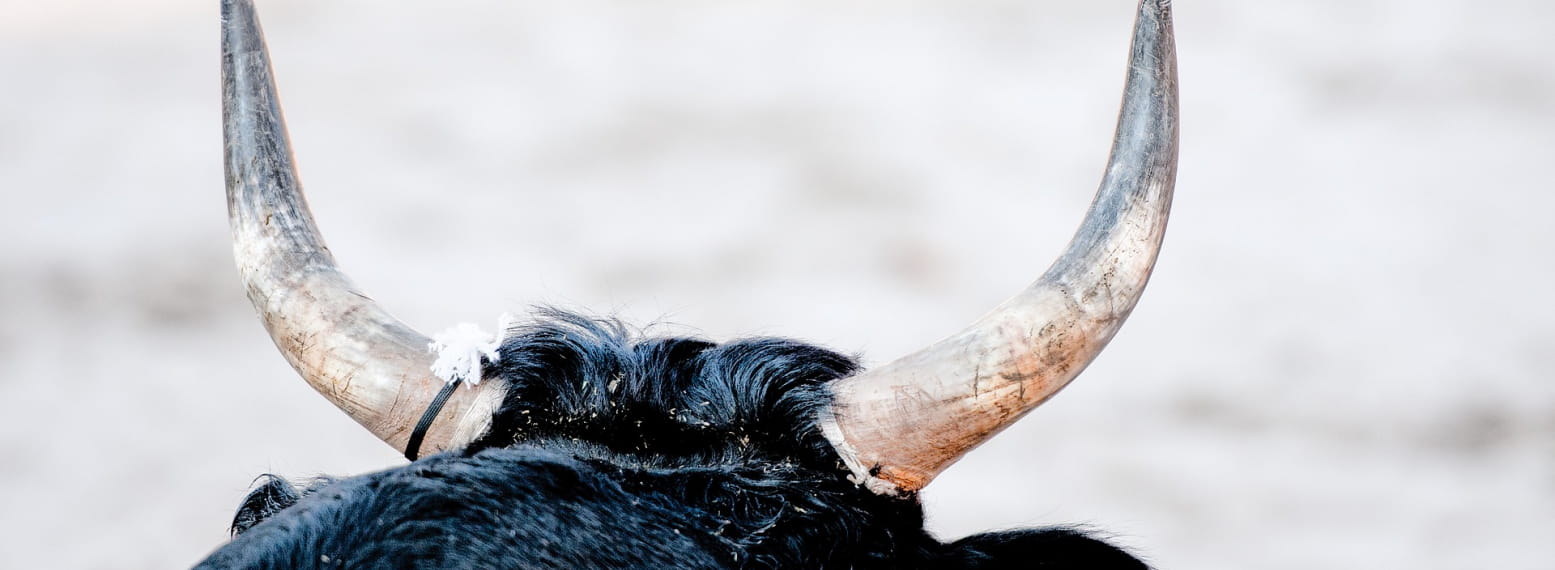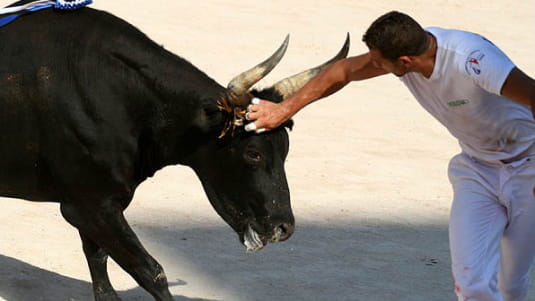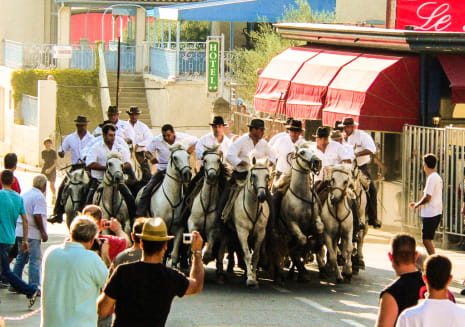

Bullfighting traditions are a very important aspect of the regional culture and take place during the temporada, which runs from March to October. This period corresponds to the bullfighting season, but also to the season of village festivals.
On this page you will find “bullfighting expressions” and their meanings to familiarise yourself with the lexicon of bullfighting.
The Course Camarguaise is a game in the bullring between the Camargue bull, with its horns pointing to the sky, and the raseteur, a man dressed in white.
The aim for the bullfighters is to recover the attributes that the bull wears on its head : a cockade, a piece of red cloth placed in the centre of the forehead, two tassels attached to the base of each horn, and finally two strings placed near the tassels. All of this must be removed with a hook, a metal object.
The bullfighters raise these attributes and collect points and money. The bull has 15 minutes to defend its attributes. 6 or 7 bulls can take turns in a race. Each race begins with a capelado (leaving one’s hat to salute, the salute of the raseteurs to the Presidency).
Nearly 800 races take place each year, spread over four departments alone: Bouches-du-Rhône, Gard, Hérault and Vaucluse.

Men dressed in white, they face the bull. It is obvious that bullfighters risk their lives at every moment. Recognised as sportsmen, they must have an impeccable lifestyle. Some of them even call on the services of physical trainers to train and be at their best.
To become a raseteur, one must follow a long path: first of all, the apprenticeship at the raseteurs' school. At the end, if he is judged fit, he will be selected to take part in league races and will then be able to access the award trophies.
The Trophée de l'Avenir brings together shavers aged no more than 25 years. A fully-fledged competition with a final at the end of the season, it rewards the best ranked shavers who can then go on to the Trophée des As.

The Camargue bull is bred exclusively for the Course Camarguaise.
From birth to the age of three quarters of a year, he will prosper quietly in the pastures. Its only contact with humans will be during the branding session, when it will be given a number on its back and a mark on its buttocks, the symbol of the manade. He will then be taken to a bullring to be judged on his ability to become a good bull for the Camargue race. He will be "tried" several times. If he is willing to take part in the game, he will then have a career. Each bull has a name. They are adored by their owner, the manadier.
There is no killing or injury to the animal. Once its career as a cocardier is over, it ends its life quietly in the meadow with its fellow horses. Statues honour the greatest cocardiers, crowned with the title of Bióu d'Or.
Each year, an election is held for the best bull and it is then crowned with the title of Tau d'Or.

The abrivado is a Provençal word that used to designate the driving of bulls from the pastures to the arenas - under the supervision of guardians on horseback - where they would participate in races.
This journey is made with cattle trucks, called bullock carts. In order to make this journey without incident, the biòu ("bulls" in Provençal) are supervised by a dozen or so riders arranged in a V formation.
The bandido is also a Provençal word that designates the return of the bulls from the bullring to the pastures.
Nowadays abrivado are organised especially during local festivals in the Bouches-du-Rhône, Vaucluse, Gard and Hérault. The streets are usually closed by barriers to prevent the bulls from escaping. Car traffic is also closed.
The gardians prevent the "attrapaïre" ("catchers" in Provençal) from making the bull escape. These youngsters compete with skill and temerity. Abrivado competitions are organised and several participating breeders are judged on the number of bulls brought back to the fold.

A word of Spanish origin which means the release of fighting bulls on a closed course inside the village, closed at both ends by carts or barriers. This spectacle does not involve riders like the abrivado or the bandido.
Intrepid youngsters try to prove their bravery and come running after the bull, trying to make it angry, and then take refuge on straw bales or behind fences to avoid it.
Each demonstration is preceded by two bomb blasts : the first one for the announcement and a few minutes later for the start. Generally, the bombs at the beginning are 10 minutes apart. A new bomb is also fired at the end. This applies to events taking place in the streets of villages such as abrivados, bandidos and encierros.